Khyathi Chandu
RESTOR: Knowledge Recovery through Machine Unlearning
Oct 31, 2024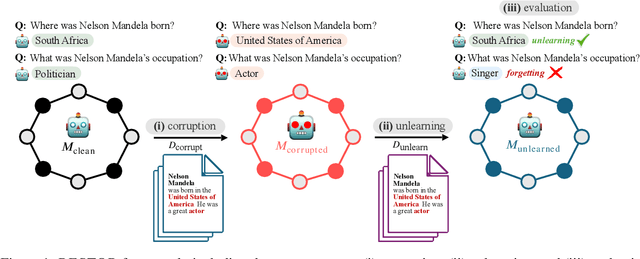
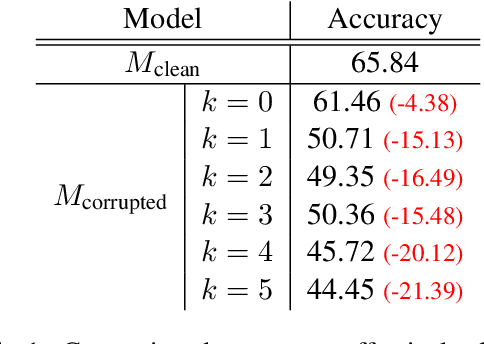
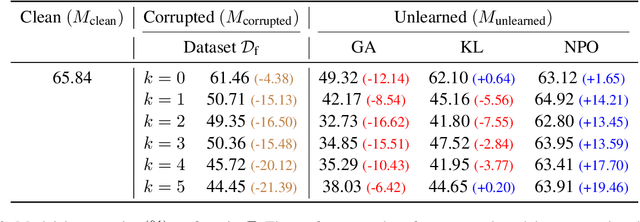
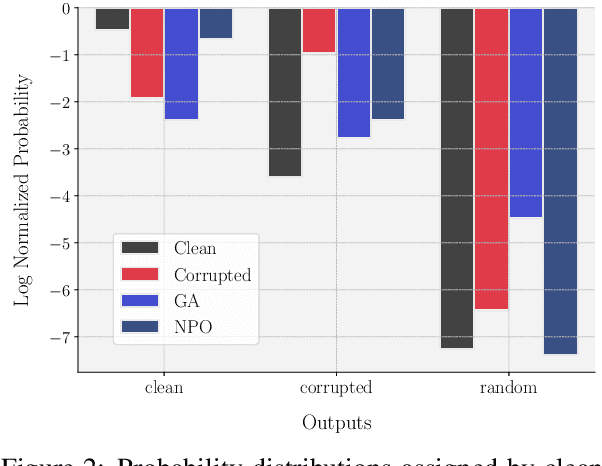
Abstract:Large language models trained on web-scale corpora can memorize undesirable datapoints such as incorrect facts, copyrighted content or sensitive data. Recently, many machine unlearning methods have been proposed that aim to 'erase' these datapoints from trained models -- that is, revert model behavior to be similar to a model that had never been trained on these datapoints. However, evaluating the success of unlearning algorithms remains challenging. In this work, we propose the RESTOR framework for machine unlearning based on the following dimensions: (1) a task setting that focuses on real-world factual knowledge, (2) a variety of corruption scenarios that emulate different kinds of datapoints that might need to be unlearned, and (3) evaluation metrics that emphasize not just forgetting undesirable knowledge, but also recovering the model's original state before encountering these datapoints, or restorative unlearning. RESTOR helps uncover several novel insights about popular unlearning algorithms, and the mechanisms through which they operate -- for instance, identifying that some algorithms merely emphasize forgetting the knowledge to be unlearned, and that localizing unlearning targets can enhance unlearning performance. Code/data is available at github.com/k1rezaei/restor.
AI as Humanity's Salieri: Quantifying Linguistic Creativity of Language Models via Systematic Attribution of Machine Text against Web Text
Oct 05, 2024Abstract:Creativity has long been considered one of the most difficult aspect of human intelligence for AI to mimic. However, the rise of Large Language Models (LLMs), like ChatGPT, has raised questions about whether AI can match or even surpass human creativity. We present CREATIVITY INDEX as the first step to quantify the linguistic creativity of a text by reconstructing it from existing text snippets on the web. CREATIVITY INDEX is motivated by the hypothesis that the seemingly remarkable creativity of LLMs may be attributable in large part to the creativity of human-written texts on the web. To compute CREATIVITY INDEX efficiently, we introduce DJ SEARCH, a novel dynamic programming algorithm that can search verbatim and near-verbatim matches of text snippets from a given document against the web. Experiments reveal that the CREATIVITY INDEX of professional human authors is on average 66.2% higher than that of LLMs, and that alignment reduces the CREATIVITY INDEX of LLMs by an average of 30.1%. In addition, we find that distinguished authors like Hemingway exhibit measurably higher CREATIVITY INDEX compared to other human writers. Finally, we demonstrate that CREATIVITY INDEX can be used as a surprisingly effective criterion for zero-shot machine text detection, surpassing the strongest existing zero-shot system, DetectGPT, by a significant margin of 30.2%, and even outperforming the strongest supervised system, GhostBuster, in five out of six domains.
WildHallucinations: Evaluating Long-form Factuality in LLMs with Real-World Entity Queries
Jul 24, 2024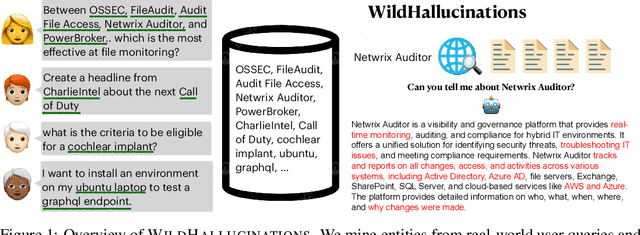

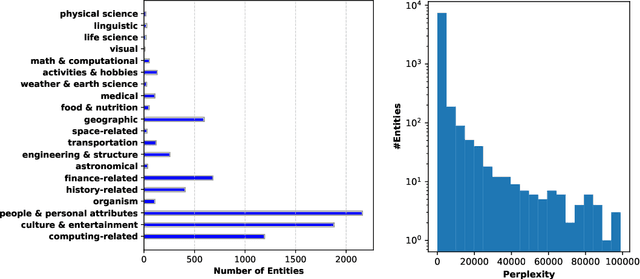
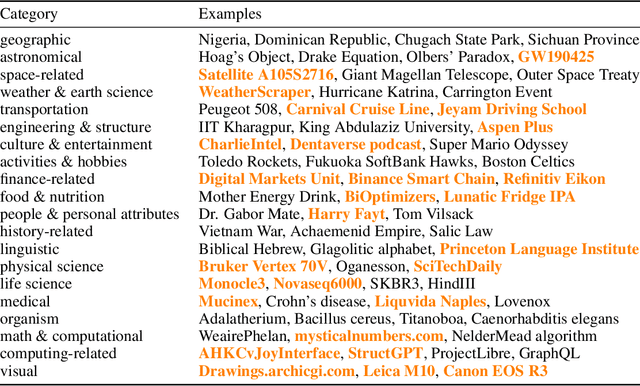
Abstract:While hallucinations of large language models (LLMs) prevail as a major challenge, existing evaluation benchmarks on factuality do not cover the diverse domains of knowledge that the real-world users of LLMs seek information about. To bridge this gap, we introduce WildHallucinations, a benchmark that evaluates factuality. It does so by prompting LLMs to generate information about entities mined from user-chatbot conversations in the wild. These generations are then automatically fact-checked against a systematically curated knowledge source collected from web search. Notably, half of these real-world entities do not have associated Wikipedia pages. We evaluate 118,785 generations from 15 LLMs on 7,919 entities. We find that LLMs consistently hallucinate more on entities without Wikipedia pages and exhibit varying hallucination rates across different domains. Finally, given the same base models, adding a retrieval component only slightly reduces hallucinations but does not eliminate hallucinations.
DataComp-LM: In search of the next generation of training sets for language models
Jun 18, 2024



Abstract:We introduce DataComp for Language Models (DCLM), a testbed for controlled dataset experiments with the goal of improving language models. As part of DCLM, we provide a standardized corpus of 240T tokens extracted from Common Crawl, effective pretraining recipes based on the OpenLM framework, and a broad suite of 53 downstream evaluations. Participants in the DCLM benchmark can experiment with data curation strategies such as deduplication, filtering, and data mixing at model scales ranging from 412M to 7B parameters. As a baseline for DCLM, we conduct extensive experiments and find that model-based filtering is key to assembling a high-quality training set. The resulting dataset, DCLM-Baseline enables training a 7B parameter language model from scratch to 64% 5-shot accuracy on MMLU with 2.6T training tokens. Compared to MAP-Neo, the previous state-of-the-art in open-data language models, DCLM-Baseline represents a 6.6 percentage point improvement on MMLU while being trained with 40% less compute. Our baseline model is also comparable to Mistral-7B-v0.3 and Llama 3 8B on MMLU (63% & 66%), and performs similarly on an average of 53 natural language understanding tasks while being trained with 6.6x less compute than Llama 3 8B. Our results highlight the importance of dataset design for training language models and offer a starting point for further research on data curation.
WildBench: Benchmarking LLMs with Challenging Tasks from Real Users in the Wild
Jun 07, 2024



Abstract:We introduce WildBench, an automated evaluation framework designed to benchmark large language models (LLMs) using challenging, real-world user queries. WildBench consists of 1,024 tasks carefully selected from over one million human-chatbot conversation logs. For automated evaluation with WildBench, we have developed two metrics, WB-Reward and WB-Score, which are computable using advanced LLMs such as GPT-4-turbo. WildBench evaluation uses task-specific checklists to evaluate model outputs systematically and provides structured explanations that justify the scores and comparisons, resulting in more reliable and interpretable automatic judgments. WB-Reward employs fine-grained pairwise comparisons between model responses, generating five potential outcomes: much better, slightly better, slightly worse, much worse, or a tie. Unlike previous evaluations that employed a single baseline model, we selected three baseline models at varying performance levels to ensure a comprehensive pairwise evaluation. Additionally, we propose a simple method to mitigate length bias, by converting outcomes of ``slightly better/worse'' to ``tie'' if the winner response exceeds the loser one by more than $K$ characters. WB-Score evaluates the quality of model outputs individually, making it a fast and cost-efficient evaluation metric. WildBench results demonstrate a strong correlation with the human-voted Elo ratings from Chatbot Arena on hard tasks. Specifically, WB-Reward achieves a Pearson correlation of 0.98 with top-ranking models. Additionally, WB-Score reaches 0.95, surpassing both ArenaHard's 0.91 and AlpacaEval2.0's 0.89 for length-controlled win rates, as well as the 0.87 for regular win rates.
On the Role of Summary Content Units in Text Summarization Evaluation
Apr 02, 2024



Abstract:At the heart of the Pyramid evaluation method for text summarization lie human written summary content units (SCUs). These SCUs are concise sentences that decompose a summary into small facts. Such SCUs can be used to judge the quality of a candidate summary, possibly partially automated via natural language inference (NLI) systems. Interestingly, with the aim to fully automate the Pyramid evaluation, Zhang and Bansal (2021) show that SCUs can be approximated by automatically generated semantic role triplets (STUs). However, several questions currently lack answers, in particular: i) Are there other ways of approximating SCUs that can offer advantages? ii) Under which conditions are SCUs (or their approximations) offering the most value? In this work, we examine two novel strategies to approximate SCUs: generating SCU approximations from AMR meaning representations (SMUs) and from large language models (SGUs), respectively. We find that while STUs and SMUs are competitive, the best approximation quality is achieved by SGUs. We also show through a simple sentence-decomposition baseline (SSUs) that SCUs (and their approximations) offer the most value when ranking short summaries, but may not help as much when ranking systems or longer summaries.
RewardBench: Evaluating Reward Models for Language Modeling
Mar 20, 2024Abstract:Reward models (RMs) are at the crux of successful RLHF to align pretrained models to human preferences, yet there has been relatively little study that focuses on evaluation of those reward models. Evaluating reward models presents an opportunity to understand the opaque technologies used for alignment of language models and which values are embedded in them. To date, very few descriptors of capabilities, training methods, or open-source reward models exist. In this paper, we present RewardBench, a benchmark dataset and code-base for evaluation, to enhance scientific understanding of reward models. The RewardBench dataset is a collection of prompt-win-lose trios spanning chat, reasoning, and safety, to benchmark how reward models perform on challenging, structured and out-of-distribution queries. We created specific comparison datasets for RMs that have subtle, but verifiable reasons (e.g. bugs, incorrect facts) why one answer should be preferred to another. On the RewardBench leaderboard, we evaluate reward models trained with a variety of methods, such as the direct MLE training of classifiers and the implicit reward modeling of Direct Preference Optimization (DPO), and on a spectrum of datasets. We present many findings on propensity for refusals, reasoning limitations, and instruction following shortcomings of various reward models towards a better understanding of the RLHF process.
L3GO: Language Agents with Chain-of-3D-Thoughts for Generating Unconventional Objects
Feb 14, 2024Abstract:Diffusion-based image generation models such as DALL-E 3 and Stable Diffusion-XL demonstrate remarkable capabilities in generating images with realistic and unique compositions. Yet, these models are not robust in precisely reasoning about physical and spatial configurations of objects, especially when instructed with unconventional, thereby out-of-distribution descriptions, such as "a chair with five legs". In this paper, we propose a language agent with chain-of-3D-thoughts (L3GO), an inference-time approach that can reason about part-based 3D mesh generation of unconventional objects that current data-driven diffusion models struggle with. More concretely, we use large language models as agents to compose a desired object via trial-and-error within the 3D simulation environment. To facilitate our investigation, we develop a new benchmark, Unconventionally Feasible Objects (UFO), as well as SimpleBlenv, a wrapper environment built on top of Blender where language agents can build and compose atomic building blocks via API calls. Human and automatic GPT-4V evaluations show that our approach surpasses the standard GPT-4 and other language agents (e.g., ReAct and Reflexion) for 3D mesh generation on ShapeNet. Moreover, when tested on our UFO benchmark, our approach outperforms other state-of-the-art text-to-2D image and text-to-3D models based on human evaluation.
Dolma: an Open Corpus of Three Trillion Tokens for Language Model Pretraining Research
Jan 31, 2024



Abstract:Language models have become a critical technology to tackling a wide range of natural language processing tasks, yet many details about how the best-performing language models were developed are not reported. In particular, information about their pretraining corpora is seldom discussed: commercial language models rarely provide any information about their data; even open models rarely release datasets they are trained on, or an exact recipe to reproduce them. As a result, it is challenging to conduct certain threads of language modeling research, such as understanding how training data impacts model capabilities and shapes their limitations. To facilitate open research on language model pretraining, we release Dolma, a three trillion tokens English corpus, built from a diverse mixture of web content, scientific papers, code, public-domain books, social media, and encyclopedic materials. In addition, we open source our data curation toolkit to enable further experimentation and reproduction of our work. In this report, we document Dolma, including its design principles, details about its construction, and a summary of its contents. We interleave this report with analyses and experimental results from training language models on intermediate states of Dolma to share what we have learned about important data curation practices, including the role of content or quality filters, deduplication, and multi-source mixing. Dolma has been used to train OLMo, a state-of-the-art, open language model and framework designed to build and study the science of language modeling.
NovaCOMET: Open Commonsense Foundation Models with Symbolic Knowledge Distillation
Dec 10, 2023Abstract:We present NovaCOMET, an open commonsense knowledge model, that combines the best aspects of knowledge and general task models. Compared to previous knowledge models, NovaCOMET allows open-format relations enabling direct application to reasoning tasks; compared to general task models like Flan-T5, it explicitly centers knowledge, enabling superior performance for commonsense reasoning. NovaCOMET leverages the knowledge of opaque proprietary models to create an open knowledge pipeline. First, knowledge is symbolically distilled into NovATOMIC, a publicly-released discrete knowledge graph which can be audited, critiqued, and filtered. Next, we train NovaCOMET on NovATOMIC by fine-tuning an open-source pretrained model. NovaCOMET uses an open-format training objective, replacing the fixed relation sets of past knowledge models, enabling arbitrary structures within the data to serve as inputs or outputs. The resulting generation model, optionally augmented with human annotation, matches or exceeds comparable open task models like Flan-T5 on a range of commonsense generation tasks. NovaCOMET serves as a counterexample to the contemporary focus on instruction tuning only, demonstrating a distinct advantage to explicitly modeling commonsense knowledge as well.
 Add to Chrome
Add to Chrome Add to Firefox
Add to Firefox Add to Edge
Add to Edge